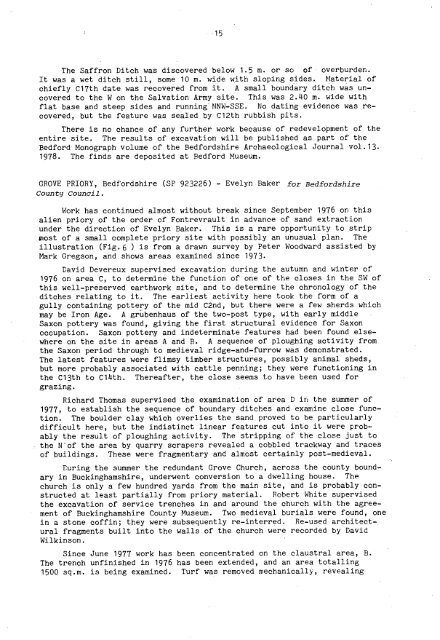Untitled - Council for British Archaeology
Untitled - Council for British Archaeology
Untitled - Council for British Archaeology
- No tags were found...
You also want an ePaper? Increase the reach of your titles
YUMPU automatically turns print PDFs into web optimized ePapers that Google loves.
15The Saffron Ditch was discovered below 1.5 m. or so of overburden.It was a wet ditch still, some 10 m. wide with sloping sides. Material ofchiefly C17th date was recovered from it. A small boundary ditch was uncoveredto the W on the Salvation Army site. This was 2.40 m. wide withflat base and steep sides and running NNW-SSE. No dating evidence was recovered,but the feature was sealed by C12th rubbish pits.There is no chance of any further work because of redevelopment of theentire site. The results of excavation will be published as part of theBed<strong>for</strong>d Monograph volume of the Bed<strong>for</strong>dshire Archaeological Journal vol.13.1978. The finds are deposited at Bed<strong>for</strong>d Museum.GROVE PRIORY, Bed<strong>for</strong>dshire (SP 923226) - Evelyn Baker <strong>for</strong> Bed<strong>for</strong>dshireCounty <strong>Council</strong>.Work has continued almost without break since September 1976 on thisalien priory of the order of Fontrevrault in advance of sand extractionunder the direction of Evelyn Baker. This is a rare opportunity to stripmost of a small complete priory site with possibly an unusual plan. Theillustration (Fig.6 ) is from a drawn survey by Peter Woodward assisted byMark Gregson, and shows areas examined since 1973.David Devereux supervised excavation during the autumn and winter of1976 on area C, to determine the function of one of the closes in the SW ofthis well-preserved earthwork site, and to determine the chronology of theditches relating to it. The earliest activity here took the <strong>for</strong>m of agully containing pottery of the mid C2nd, but there were a few sherds whichmay be Iron Age. A gri.lbenhaus of the two-post type, with early middleSaxon pottery was found, giving the first structural evidence <strong>for</strong> Saxonoccupation. Saxon pottery and indeterminate features had been found elsewhereon the site in areas A and B. A sequence of ploughing activity fromthe Saxon period through to medieval ridge-and-furrow was demonstrated.The latest features were flimsy timber structures, possibly animal sheds,but more probably associated with cattle penning; they were functioning inthe C13th to C14th. Thereafter, the close seems to have been used <strong>for</strong>grazing.Richard Thomas supervised the examination of area D in the summer of1977, to establish the sequence of boundary ditches and examine close function.The boulder clay which overlies the sand proved to be particularlydifficult here, but the indistinct linear features cut into it were probablythe result of ploughing activity. The stripping of the close just tothe N'of the area by quarry scrapers revealed a cobbled trackway and tracesof buildings. These were fragmentary and almost certainly post-medieval.ruring the summer the redundant Grove Church, across the county boundaryin Buckinghamshire, underwent conversion to a dwelling house. Thechurch is only a few hundred yards from the main site, and is probably constructedat least partially from priory material. Robert White supervisedthe excavation of service trenches in and around the church with the agreementof Buckinghamshire County Museum. Two medieval burials were found, onein a stone coffin; they were subsequently re-interred. Re-used architecturalfragments built into the walls of the church were recorded by DavidWilkinson.Since June 1977 work has been concentrated on the claustral area,The trench unfinished in 1976 has been extended, and an area totalling1500 sq.m. is being examined. Turf was removed mechanically, revealing
















